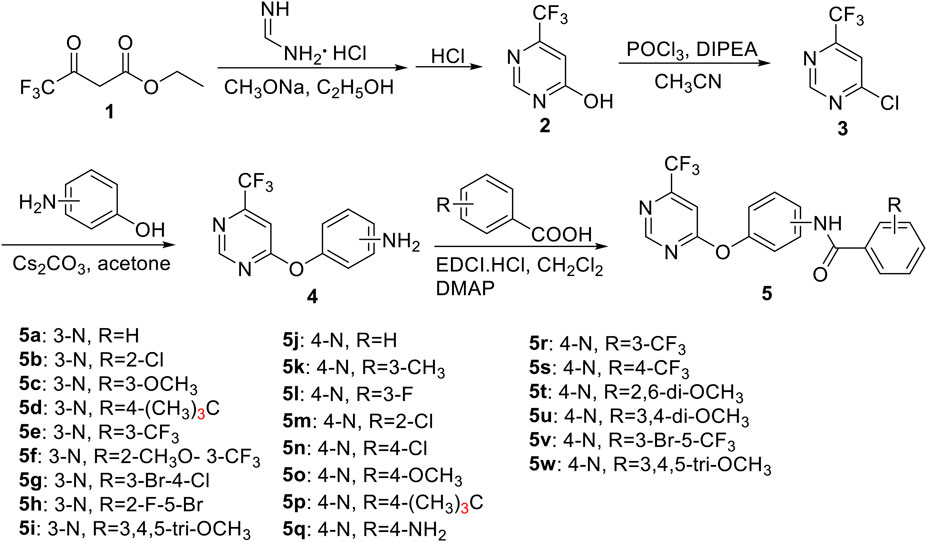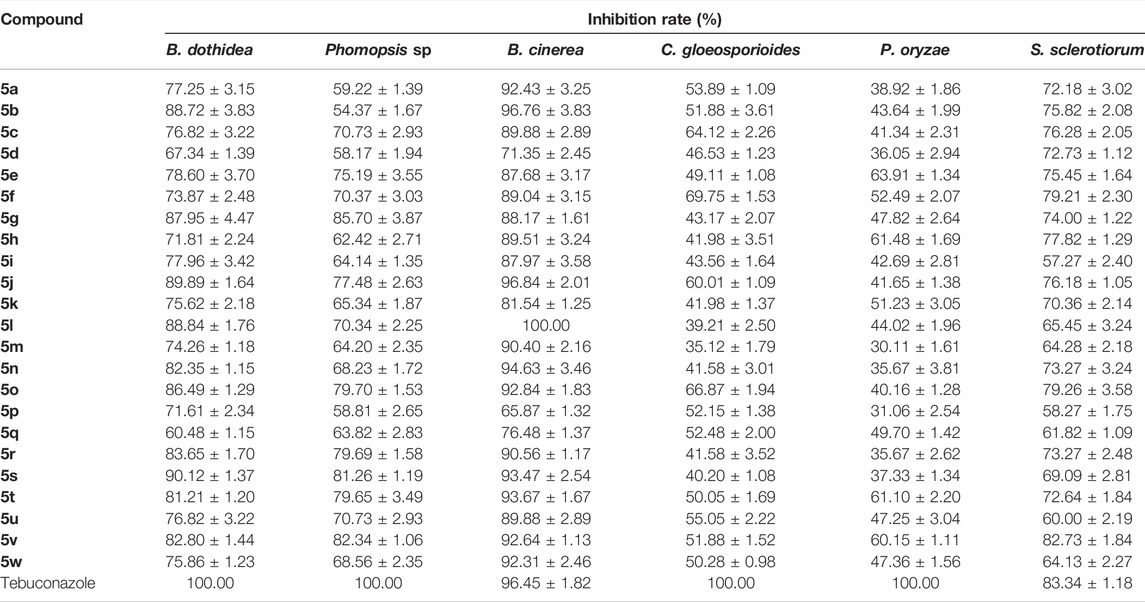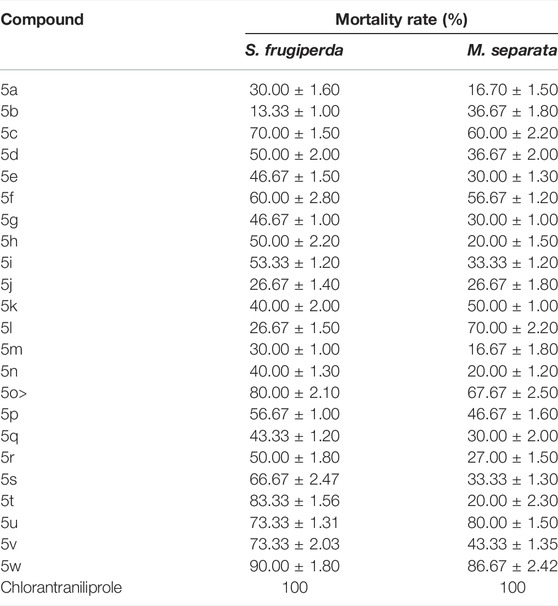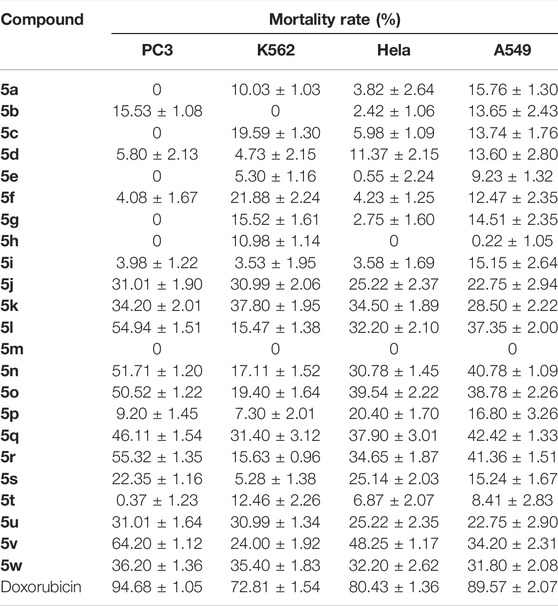- 1Food and Pharmaceutical Engineering Institute, Guiyang University, Guiyang, China
- 2State Key Laboratory of Functions and Applications of Medicinal Plants, Guizhou Medical University, Guiyang, China
- 3Qiandongnan Engineering and Technology Research Center for Comprehensive Utilization of National Medicine, Kaili University, Kaili, China
Twenty-three novel trifluoromethyl pyrimidine derivatives containing an amide moiety were designed and synthesized through four-step reactions and evaluated for their antifungal, insecticidal, and anticancer properties. Bioassay results indicated that some of the title compounds exhibited good in vitro antifungal activities against Botryosphaeria dothidea (B. dothidea), Phompsis sp., Botrytis cinereal (B. cinerea), Colletotrichum gloeosporioides (C. gloeosporioides), Pyricutaria oryzae (P. oryzae), and Sclerotinia sclerotiorum (S. sclerotiorum) at 50 μg/ml. Meanwhile, the synthesized compounds showed moderate insecticidal activities against Mythimna separata (M. separata) and Spdoptera frugiperda (S. frugiperda) at 500 μg/ml, which were lower than those of chlorantraniliprole. In addition, the synthesized compounds indicated certain anticancer activities against PC3, K562, Hela, and A549 at 5 μg/ml, which were lower than those of doxorubicin. Notably, this work is the first report on the antifungal, insecticidal, and anticancer activities of trifluoromethyl pyrimidine derivatives bearing an amide moiety.
Introduction
In recent years, in the field of agricultural production, drug resistance and cross-resistance of existing pesticides continue to develop, and the development of efficient and new pesticides is still an urgent task for scientific researchers (Wei et al., 2021). Due to their unique biological structure, nitrogen-containing heterocyclic compounds have the characteristics of high target specificity and good environmental compatibility, which have become a research hotspot in the creation of new pesticides (Mermer et al., 2021). Among them, pyrimidine is an important lead molecule and an active fragment in the design of biologically active molecules, which is widely used in the design of pesticides and pharmaceutical molecules (Abbas et al., 2021), plant growth regulation (Tsygankova et al., 2018), and other biological activities. Many pyrimidine pesticide molecules are on the market, such as azoxystrobin, fluoxastrobin, pyrimethamine sulfonate, pyrimfen, cyclopropenyl, sulfluramid, and sulfonylureas. Especially in the prevention and treatment of plant fungal diseases, pyrimidine fungicides have become one of the hot spots in the research on new pesticides (Borthakur et al., 2020). In the medicine field, pyrimidine has broad-spectrum biological activity including anti-viral, anti-inflammatory, anti-cancer, and anti-HIV activities (Abdel-Aziz et al., 2021; Abu-Zaied et al., 2021; Ding et al., 2022; Li et al., 2022). Therefore, the molecular design, synthesis, and biological activity of pyrimidine derivatives are still one of the hot research topics in pesticide chemistry (Zhang et al., 2020).
Amide, an important negatively charged organic functional group, was widely present in active compounds, which has a broad spectrum of biological activities and is widely used in the field of pesticides and medicine (Maftei et al., 2015; Bhat et al., 2017). According to statistics, 25% of small-molecule drugs currently in the market contain at least one amide bond in their molecular structure (Kumari et al., 2020). At present, the fungicides of amide compounds have been used for decades, and the application of fungicides is the most effective measure to control phytopathogenic fungi. The use of fungicides can restore a lot of losses every year (Simkhada and Thapa, 2021; Wang R.-X. et al., 2021). The commercial varieties that have been developed include fentanyl, fluopicolide, flutolanil penthiopyrad, boscalid, etc. Amide fungicides can effectively prevent and control sheath blight, scab, and sclerotinia on crops such as wheat, corn, rapeseed, and rice. It can also effectively prevent and control fusarium wilt on tomato and potato diseases (AL-Shammri et al., 2022). In our previous work, a series of synthesized pyrimidine-containing substituted amide derivatives exhibited good antifungal activity.
Based on the aforementioned considerations and our previous works (Wu et al., 2019; Wu et al., 2020; Wu et al., 2021; Yu et al., 2021), the amide is linked to the trifluoromethyl pyrimidine backbone through an oxygen ether. Finally, we designed and synthesized a novel series of trifluoromethyl pyrimidine derivatives containing an amide moiety due to the molecularly active splicing strategy (Figure 1).
Materials and Methods
General Information
Melting points (m.p.) of the target compounds were tested on an XT-4 binocular microscope (Beijing Tech Instrument Co., China). 1H nuclear magnetic resonance (NMR) and 13C nuclear magnetic resonance (NMR) (solvent DMSO-d6) spectral analyses were performed on a Bruker AvanceNEO spectrometer (600 MHz, Bruker, Germany) at room temperature. High-resolution mass spectrometry (HRMS) data were obtained on a Thermo Scientific Q Exactive Focus instrument (Thermo Fisher Scientific, Unites States). Analytical thin-layer chromatography (TLC) was prepared on silica gel GF254.
Preparation of the Intermediates 2–4
Intermediates 2 and 3 were prepared using our previous research method in Scheme 1 (Wu et al., 2019).
To a 100-ml three-necked bottle, intermediate 3 (20 mmol), KI (0.2 mmol), Cs2CO3 (30 mmol), and acetone (50 ml) were stirred under ice bath conditions. Then, dissolved 3-aminophenol or 4-aminophenol (20 mmol) in acetone (10 ml) was added dropwise, which continued to react for 7–8 h at 25°C. The chromatographic column was installed and eluted with petroleum ether and ethyl acetate in different proportions to gain intermediate 4.
3-((6-(Trifluoromethyl)pyrimidin-4-yl)oxy)aniline (4a). White solid; yield 62.5%; m. p. 65–67°C; 1H NMR (600 MHz, DMSO-d6, ppm) δ: 8.94 (s, 1H, pyrimidine-H), 7.29 (s, 1H, pyrimidine-H), 7.06 (t, 2H, J = 7.8 Hz, Ph-H), 6.62 (d, 1H, J = 7.8 Hz, Ph-H), 6.42 (t, 1H, J = 2.4 Hz, Ph-H), 6.38 (d, 1H, J = 7.8 Hz, Ph-H), 5.40 (s, 2H, NH2); 13C NMR (125 MHz, DMSO-d6, ppm)δ: 171.50, 169.88, 156.13 (q,J = 35.4 Hz), 147.42, 142.18, 122.26, 121.82 (q, J = 273.3 Hz), 114.96, 102.48; HRMS (ESI) calculated for C11H9ON3F3 [M + H]+: 256.06839, found: 256.06922.
4-((6-(Trifluoromethyl)pyrimidin-4-yl)oxy)aniline (4b). White solid; yield 70.6%; m. p. 85–87°C; 1H NMR (600 MHz, DMSO-d6, ppm)δ: 8.96 (s, 1H, pyrimidine-H), 7.55 (s, 1H, pyrimidine-H), 6.93 (d, 2H, J = 9.0 Hz, Ph-H), 6.65 (d, 2H, J = 8.5 Hz, Ph-H), 5.17 (s, 2H, NH2); 13C NMR (125 MHz, DMSO-d6, ppm) δ: 171.41, 159.88, 156.09 (q, J = 35.1 Hz), 147.45, 142.06, 122.17, 121.82 (q, J = 272.7 Hz), 114.83, 105.83; HRMS (ESI) calculated for C11H9ON3F3 [M + H]+: 256.06839, found: 256.06910.
Preparation of the Target Compounds 5a–5w
To a 50-ml three-necked bottle, the key intermediate 4 (0.02 mol), aromatic acid (0.024 mol), and dimethylaminopyridine (DMAP, 0.0004 mol), dissolved in dichloromethane (20 ml), and 1-(3-dimethylaminopropyl)-3-ethylcarbodiimide hydrochloride (EDCI, 0.03 mol) were added. The reactions were stirred at 25°C for 8–10 h. Then, the solvent was evaporated under vacuum and the residue was purified by column chromatography (ethyl acetate/petroleum ether = 10/1) to obtain the target compounds 5a–5w.
N-(3-((6-(trifluoromethyl)pyrimidin-4-yl)oxy)phenyl)benzamide (5a). White solid; yield 53.4%; m. p. 125–127°C; 1H NMR (600 MHz, DMSO-d6, ppm) δ: 10.46 (s, 1H, -CONH-), 8.99 (s, 1H, pyrimidine), 7.83 (d, 2H, J = 7.2 Hz, Ph-H), 7.71 (t, 1H, J = 1.8 Hz, Ph-H), 7.78 (s, 1H, Ph-H), 7.72 (d, 1H, J = 8.4 Hz, Ph-H), 7.62 (t, 1H, J = 7.8 Hz, Ph-H), 7.56 (t, 1H, J = 7.8 Hz, Ph-H), 7.49 (t, 1H, J = 7.8 Hz, Ph-H), 7.04 (dd, 1H, J1 = 1.8 Hz, J2 = 8.4 Hz, Ph-H); 13C NMR (150 MHz, DMSO-d6, ppm) δ: 170.61, 166.25, 159.84, 156.13 (q, J = 35.6 Hz), 152.21, 141.21, 135.17, 132.19, 130.37, 128.88, 128.15, 121.81 (q, J = 273.3 Hz), 120.35, 118.30, 117.88, 117.13, 113.70, 106.66, 60.58, 55.79; HRMS (ESI) calculated for C18H12O2N3F3 [M + Na]+: 382.07681, found: 382.07725.
Crystal Data and Structure Determination
Single crystals of compound 5q (deposition CCDC1965888) (DOI: 10.5517/ccdc.csd.cc23znrj) for X-ray diffraction were acquired from absolute ethanol by slow evaporation at 25°C. The crystallographic parameters are displayed in Supplementary Table S1. Supplementary Table S1 showed that 3,107 independent reflections with the range of 2.072°≤ θ ≤ 22.729° were obtained. Compound 5q crystallized in the monoclinic system and the space group is P2 (1)/c. The crystallographic parameters are as follows: a = 17.2341 (15) Å, b = 12.1803 (11) Å, c = 10.5015 (9) Å, α = 90°, β = 97.021 (2)°, γ = 90°, μ = 0.106 mm−1, V = 2187.9 (3) Å3, Z = 4, Dc = 1.316 g cm−3, F (000) = 904.0, goodness of fit on F2 = 1.000, R1 = 0.1469, and wR2 = 0.2676. Meanwhile, the crystal structure of 5q was shown in Figure 1. Figure 2 showed that the crystal structure of compound 5q is monoclinic and contains two plane subunits of 6-(trifluoromethyl)pyrimidine and benzamide.
In Vitro Antifungal Activity Test
The antifungal activities against Botryosphaeria dothidea (B. dothidea), Phompsis sp., Botrytis cinereal (B. cinerea), Colletotrichum gloeosporioides (C. gloeosporioides), Pyricutaria oryzae (P. oryzae), and Sclerotinia sclerotiorum (S. sclerotiorum) of compounds 5a–5w at 50 μg/ml were determined by the typical mycelium growth rate method (Du et al., 2021; Wang W. et al., 2021), and tebuconazole was used as a positive control.
Insecticidal Activity Test
The insecticidal activities against Spdoptera frugiperda (S. frugiperda) and Mythimna separata (M. separata) of compounds 5a–5w at 500 µg/mL were conducted according to the research method in the literature (Wang et al., 2020). Chlorantraniliprole was used as a positive control. Three replicates were performed for each treatment. The corrected mortality rate of compounds 5a–5w were evaluated by the Abbott’s formula.
Anticancer Activity Test
The anticancer activities against the cells of compounds 5a–5w at 5 µg/mL were conducted based on the MTT method (El-Dydamony et al., 2022). Doxorubicin was used as a positive control. Each treatment was repeated 3 times. The corrected mortality rates for compounds 5a–5w were determined using the aforementioned formula.
Results and Discussion
Chemistry
Using ethyl trifluoroacetoacetate as the initial reagent, as shown in Scheme 1, a series of novel trifluoromethyl pyrimidine derivatives bearing an amide moiety were designed and synthesized via four-step reactions with the yields of 20.2–60.8% and the target compounds were characterized by 1H NMR, 13C NMR, X-ray diffraction, and HRMS.
The 1H NMR signals for compound 5a, a singlet appears 10.46 ppm indicates the presence of the -CONH- group. The CH proton of the 6-trifluoromethyl pyrimidine ring is located as two singlets at 8.99 and 7.78 ppm. Meanwhile, in the 13C NMR data of compound 5a, two quartets at 156.13and121.81 ppm indicated the presence of -CF3and C-CF3 as characteristic peaks in the pyrimidine fragment. In addition, compound 5a was confirmed correctly with the [M + Na]+ peaks by HRMS data.
Antifungal Activity Test In Vitro
Table 1 shows that compounds 5b, 5j, and 5l revealed excellent in vitro antifungal activity against B. cinerea, with the inhibition rates of 96.76, 96.84, and 100%, respectively, which were equal to or even better than that of tebuconazole (96.45%). Meanwhile, compound 5v had an inhibitory effect (82.73%) against S. sclerotiorum equal to that of tebuconazole (83.34%). Nevertheless, compounds 5a–5w revealed lower in vitro antifungal activities against B. Dothidea (60.48–90.12%), Phomopsis sp. (54.37–82.34%), C. gloeosporioides (35.12–69.75%), and P. oryzae (30.11–63.91%) than those of tebuconazole.
Insecticidal Activity Test
Table 2 shows that compounds 5a–5w indicated certain insecticidal activities against S. frugiperda and M. separata at 500 μg/ml, with the mortality rates of 13.3–90.0% and 16.7–86.7%, respectively, which were lower than those of chlorantraniliprole. Especially, compound 5w revealed fine insecticidal activities against Spdoptera frugiperda and Mythimna separata with the mortality rates of 90.0% and 86.7%, respectively. Meanwhile, compound 5o and 5t demonstrated moderate mortality rates of 80.0% and 83.3% against Spdoptera frugiperda.
Anticancer Activity Test
Table 3 shows that compounds 5a–5w indicated certain anticancer activities against PC3 (0–64.20%), K562 (0–37.80%), Hela (0–48.25%), and A549 (0–40.78%) at 5 μg/ml which were lower than those of doxorubicin. Particularly, compounds 5l, 5n, 5o, 5r, and 5v expressed moderate anticancer activities against PC3 with the inhibition rates of 54.94, 51.71, 50.52, 55.32, and 64.20%, respectively.
The preliminary structure–activity relationship showed that most compounds exhibited good activities against B. dothidea, Phomopsis sp., and B. cinerea. Especially for B. cinerea., majority of the compounds revealed inhibition rates higher than 80%. The inhibition rate of compound 5l was even up to 100%, which was exceeded by the control drug tebuconazole (96.45%). Excellent inhibitory activities also indicated the potential of these compounds as candidates or leading structure against B. cinerea.
Conclusion
In summary, twenty-three novel trifluoromethyl pyrimidine derivatives including an amide moiety were prepared based on amide and pyrimidine pharmacophore, and their structures were confirmed by 1H NMR, 13C NMR, X-ray diffraction, and HRMS determination. The preliminary biological activity screening indicated that most of the title compounds exhibited moderate to excellent antifungal and insecticidal activities. This study demonstrated the potential of trifluoromethyl pyrimidine derivatives including an amide moiety as the effective antifungal and insecticidal agents for crop protection and should be used as the reference for future research.
Data Availability Statement
The original contributions presented in the study are included in the article/Supplementary Material; further inquiries can be directed to the corresponding authors.
Author Contributions
WL, XT, JY, and QF contributed to the synthesis, purification, and characterization of all compounds, the activity research, and prepared the original manuscript. WW, PL, and HL designed and supervised the research and revised the manuscript. All authors have read and agreed to the published version of the manuscript.
Funding
We acknowledge funds from the Science and Technology Fund Project of Guizhou (No. (2020)1Z023, No. (2020)4Y161, and No. (2022) General 194), the National Natural Science Foundation of China (No. 31701821), the project of State Key Laboratory of Functions and Applications of Medicinal Plants, Guizhou Medical University (QJHKY (2022390), and Disciplinary Talent fund of Guiyang University (No. GYURC-12).
Conflict of Interest
The authors declare that the research was conducted in the absence of any commercial or financial relationships that could be construed as a potential conflict of interest.
Publisher’s Note
All claims expressed in this article are solely those of the authors and do not necessarily represent those of their affiliated organizations, or those of the publisher, the editors and the reviewers. Any product that may be evaluated in this article, or claim that may be made by its manufacturer, is not guaranteed or endorsed by the publisher.
Supplementary Material
The Supplementary Material for this article can be found online at: https://www.frontiersin.org/articles/10.3389/fchem.2022.952679/full#supplementary-material
References
Abbas, N., Swamy, P. M. G., Dhiwar, P., Patel, S., and Giles, D. (2021). Development of Fused and Substituted Pyrimidine Derivatives as Potent Anticancer Agents (A Review). Pharm. Chem. J. 54 (12), 1215–1226. doi:10.1007/s11094-021-02346-8
Abdel-Aziz, S. A., Taher, E. S., Lan, P., Asaad, G. F., Gomaa, H. A. M., El-Koussi, N. A., et al. (2021). Design, Synthesis, and Biological Evaluation of New Pyrimidine-5-Carbonitrile Derivatives Bearing 1,3-Thiazole Moiety as Novel Anti-Inflammatory EGFR Inhibitors with Cardiac Safety Profile. Bioorg. Chem. 111, 104890. doi:10.1016/j.bioorg.2021.104890
Abu-Zaied, M. A., Elgemeie, G. H., and Mahmoud, N. M. (2021). Anti-Covid-19 Drug Analogues: Synthesis of Novel Pyrimidine Thioglycosides as Antiviral Agents against SARS-COV-2 and Avian Influenza H5N1 Viruses. ACS Omega 6 (26), 16890–16904. doi:10.1021/acsomega.1c01501
AL-Shammri, K. N., Elkanzi, N. A. A., Arafa, W. A. A., Althobaiti, I. O., Bakr, R. B., and Moustafa, S. M. N. (2022). Novel Indan-1,3-Dione Derivatives: Design, Green Synthesis, Effect against Tomato Damping-Off Disease Caused by Fusarium Oxysporum and In Silico Molecular Docking Study. Arab. J. Chem. 15 (5), 103731. doi:10.1016/j.arabjc.2022.103731
Bhat, A. R., Dongre, R. S., Naikoo, G. A., Hassan, I. U., and Ara, T. (2017). Proficient Synthesis of Bioactive Annulated Pyrimidine Derivatives: A Review. J. Taibah Univ. Sci. 11 (6), 1047–1069. doi:10.1016/j.jtusci.2017.05.005
Borthakur, S. K., Kalita, P. K., and Borthakur, S. (2020). Synthesis and Antifungal Activities of 3,5-Diphenyl-7-Amino-[1,3]-Thiazolo[3,2-A]pyrimidine-6-Nitrile Derivatives. J. Heterocycl. Chem. 57 (3), 1–5. doi:10.1002/jhet.3863
Ding, L., Pannecouque, C., De Clercq, E., Zhuang, C., and Chen, F.-E. (2022). Discovery of Novel Pyridine-Dimethyl-Phenyl-DAPY Hybrids by Molecular Fusing of Methyl-Pyrimidine-DAPYs and Difluoro-Pyridinyl-DAPYs: Improving the Druggability toward High Inhibitory Activity, Solubility, Safety, and PK. J. Med. Chem. 65 (3), 2122–2138. doi:10.1021/acs.jmedchem.1c01676
Du, S., Yuan, Q., Hu, X., Fu, W., Xu, Q., Wei, Z., et al. (2021). Synthesis and Biological Activity of Novel Antifungal Leads: 3,5-Dichlorobenzyl Ester Derivatives. J. Agric. Food Chem. 69 (51), 15521–15529. doi:10.1021/acs.jafc.1c04022
El-Dydamony, N. M., Abdelnaby, R. M., Abdelhady, R., Ali, O., Fahmy, M. I., R. Fakhr Eldeen, R., et al. (2022). Pyrimidine-5-Carbonitrile Based Potential Anticancer Agents as Apoptosis Inducers through PI3K/AKT Axis Inhibition in Leukaemia K562. J. Enzym. Inhib. Med. Chem. 37 (1), 895–911. doi:10.1080/14756366.2022.2051022
Kumari, S., Carmona, A. V., Tiwari, A. K., and Trippier, P. C. (2020). Amide Bond Bioisosteres: Strategies, Synthesis, and Successes. J. Med. Chem. 63 (21), 12290–12358. doi:10.1021/acs.jmedchem.0c00530
Li, W., Zhang, J., Wang, M., Dong, R., Zhou, X., Zheng, X., et al. (2022). Pyrimidine-Fused Dinitrogenous Penta-Heterocycles as a Privileged Scaffold for Anti-Cancer Drug Discovery. Curr. Top. Med. Chem. 22 (4), 284–304. doi:10.2174/1568026622666220111143949
Maftei, C. V., Fodor, E., Jones, P. G., Freytag, M., Franz, M. H., Kelter, G., et al. (2015). N-Heterocyclic Carbenes (NHC) with 1,2,4-Oxadiazole-Substituents Related to Natural Products: Synthesis, Structure and Potential Antitumor Activity of Some Corresponding Gold(I) and Silver(I) Complexes. Eur. J. Med. Chem. 101, 431–441. doi:10.1016/j.ejmech.2015.06.053
Mermer, A., Keles, T., and Sirin, Y. (2021). Recent Studies of Nitrogen Containing Heterocyclic Compounds as Novel Antiviral Agents: A Review. Bioorg. Chem. 114, 105076. doi:10.1016/j.bioorg.2021.105076
Simkhada, K., and Thapa, R. (2021). Rice Blast, A Major Threat to the Rice Production and its Various Management Techniques. Turk. JAF Sci.Tech. 10 (2), 147–157. doi:10.24925/turjaf.v10i2.147-157.4548
Tsygankova, V., Andrusevich, Y., Shtompel, O., Kopich, V., Solomyanny, R., Bondarenko, O., et al. (2018). Phytohormone-Like Effect of Pyrimidine Derivatives on Regulation of Vegetative Growth of Tomato. Int. J. Bot. Stud. 2 (3), 91–102. Available at: https://www.researchgate.net/publication/324123283.
Wang, B., Wang, H., Liu, H., Xiong, L., Yang, N., Zhang, Y., et al. (2020). Synthesis and Structure-Insecticidal Activity Relationship of Novel Phenylpyrazole Carboxylic Acid Derivatives Containing Fluorine Moiety. Chinese Chemical Letters.. doi:10.1016/j.cclet.2019.07.064
Wang, R.-X., Du, S.-S., Wang, J.-R., Chu, Q.-R., Tang, C., Zhang, Z.-J., et al. (2021). Design, Synthesis, and Antifungal Evaluation of Luotonin A Derivatives against Phytopathogenic Fungi. J. Agric. Food Chem. 69 (48), 14467–14477. doi:10.1021/acs.jafc.1c04242
Wang, W., Cheng, X., Cui, X., Xia, D., Wang, Z., and Lv, X. (2021). Synthesis and Biological Activity of Novel Pyrazolo[3,4‐d]pyrimidin‐4‐one Derivatives as Potent Antifungal Agent. Pest Manag. Sci. 77 (7), 3529–3537. doi:10.1002/ps.6406
Wei, L., Zhang, J., Tan, W., Wang, G., Li, Q., Dong, F., et al. (2021). Antifungal Activity of Double Schiff Bases of Chitosan Derivatives Bearing Active Halogeno-Benzenes. Int. J. Biol. Macromol. 179, 292–298. doi:10.1016/j.ijbiomac.2021.02.184
Wu, W., Chen, M., Fei, Q., Ge, Y., Zhu, Y., Chen, H., et al. (2020). Synthesis and Bioactivities Study of Novel Pyridylpyrazol Amide Derivatives Containing Pyrimidine Motifs. Front. Chem. 8, 522. doi:10.3389/fchem.2020.00522
Wu, W.-N., Chen, M.-H., Wang, R., Tu, H.-T., Yang, M.-F., and Ouyang, G.-P. (2019). Novel Pyrimidine Derivatives Containing an Amide Moiety: Design, Synthesis, and Antifungal Activity. Chem. Pap. 73, 719–729. doi:10.1007/s11696-018-0583-7
Wu, W.-N., Lan, W. J., Wu, C.-Y., and Fei, Q. (2021). Synthesis and Antifungal Activity of Pyrimidine Derivatives Containing an Amide Moiety. Front. Chem. 9, 695628. doi:10.3389/fchem.2021.695628
Yu, X., Lan, W., Chen, M., Xu, S., Luo, X., He, S., et al. (2021). Synthesis and Antifungal and Insecticidal Activities of Novel N-Phenylbenzamide Derivatives Bearing a Trifluoromethylpyrimidine Moiety. J. Chem. 2021, 8370407. doi:10.1155/2021/8370407
Keywords: amide, trifluoromethyl pyrimidine, design, synthesis, bioactivity
Citation: Lan W, Tang X, Yu J, Fei Q, Wu W, Li P and Luo H (2022) Design, Synthesis, and Bioactivities of Novel Trifluoromethyl Pyrimidine Derivatives Bearing an Amide Moiety. Front. Chem. 10:952679. doi: 10.3389/fchem.2022.952679
Received: 25 May 2022; Accepted: 13 June 2022;
Published: 15 July 2022.
Edited by:
Xuetao Xu, Wuyi University, ChinaReviewed by:
Peiyi Wang, Guizhou University, ChinaLei Yu, The Fourth Hospital of Harbin Medical University, China
Xingang Meng, Jingdezhen University, China
Copyright © 2022 Lan, Tang, Yu, Fei, Wu, Li and Luo. This is an open-access article distributed under the terms of the Creative Commons Attribution License (CC BY). The use, distribution or reproduction in other forums is permitted, provided the original author(s) and the copyright owner(s) are credited and that the original publication in this journal is cited, in accordance with accepted academic practice. No use, distribution or reproduction is permitted which does not comply with these terms.
*Correspondence: Wenneng Wu, d3V3ZW5uZW5nMTIzQDEyNi5jb20=; Pei Li, cGwxOTg5MDYyN0AxMjYuY29t; Heng Luo, bHVvaGVuZ0BnemNucC5jbg==
†These authors have contributed equally to this work
 Wenjun Lan1†
Wenjun Lan1† Wenneng Wu
Wenneng Wu Pei Li
Pei Li




